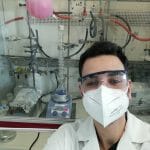Antimicrobial technology developer, Parx Materials, has created a new technique to keep fish fresher for longer. Derived from the human immune system, the technique uses a trace element of the body that occurs naturally in products such as oysters, red meat and green vegetables. The breakthrough could help to reduce the estimated 6,800 tons of fish wasted from UK supermarkets each year.
The element used in the packaging is important in our diet and is vital for the human immune system. It has important functions in blood, bone, skin, cells, nails, etc. The material in question is the trace element of zinc. However, unlike other antimicrobial additives that use metals to kill bacteria, Parx Materials has developed a way for this micronutrient to become part of the packaging material without escaping or leaking out.
Due to this unique mechanism, it is therefore a safe and healthy element that does not escape from the packaging and cannot end up on the product. The effect of the technique can be compared to the way in which the skin makes people resistant to bacteria and viruses from the outside.
“We only work with the most beautiful daily fresh products in Joelia and it was therefore a great surprise that the turbot that we had stored in vacuum for 6 days for this experiment came out of the package as good as fresh.” says Mario Ridder of Michelin star restaurant Joelia in Rotterdam.
The presence of the mineral in the skin and in the packaging ensures that bacteria cannot adhere to these surfaces. Bacteria are not killed, but by preventing adhesion, there is no accumulation or colony of bacteria on the surface. For most bacteria, attachment is necessary to enable them to take in food and to multiply. Without attachment, no new bacteria will appear and the bacteria already present will simply die according to their normal life cycle, which is an average period of about three to four hours.
“The quality of fresh salmon and tuna that we package starts to decline after 7 days, and that determines the shelf life of the product.” says Martijn Spilt of Maxima Seafood, processor of fresh fish from IJmuiden. “In the organoleptic tests that we carried out, the fish in the packaging with this technique turned out to receive the highest quality scores after 12 days. In particular, the total absence of fragrance and leakage fluid was remarkable. In addition, the product had a better color and gloss compared with the pieces packed in foil without technology. “
“The fresh ray, a product that often does not keep well in vacuum packaging, came out of the packaging with technology after 5 days. There is no difference in smell compared to the fresh scent.” says Pierre Devriendt , owner of restaurant Oesterput in Blankenberge, Belgium.
“We could also call the difference ‘bizarre’, the packaged fresh salmon was so much fresher after seven days in a pack with technology compared to normal. This provides an important added value for us”, according to Seth van Dienst of fish trader Ruud den Haan in Rotterdam.
Fish is seen as a high value product. When the freshness can be maintained for longer, it provides additional opportunities for distribution and results in less food waste. For more information on Parx Materials and to enquire about the packaging, please visit www.parxmaterials.com.








